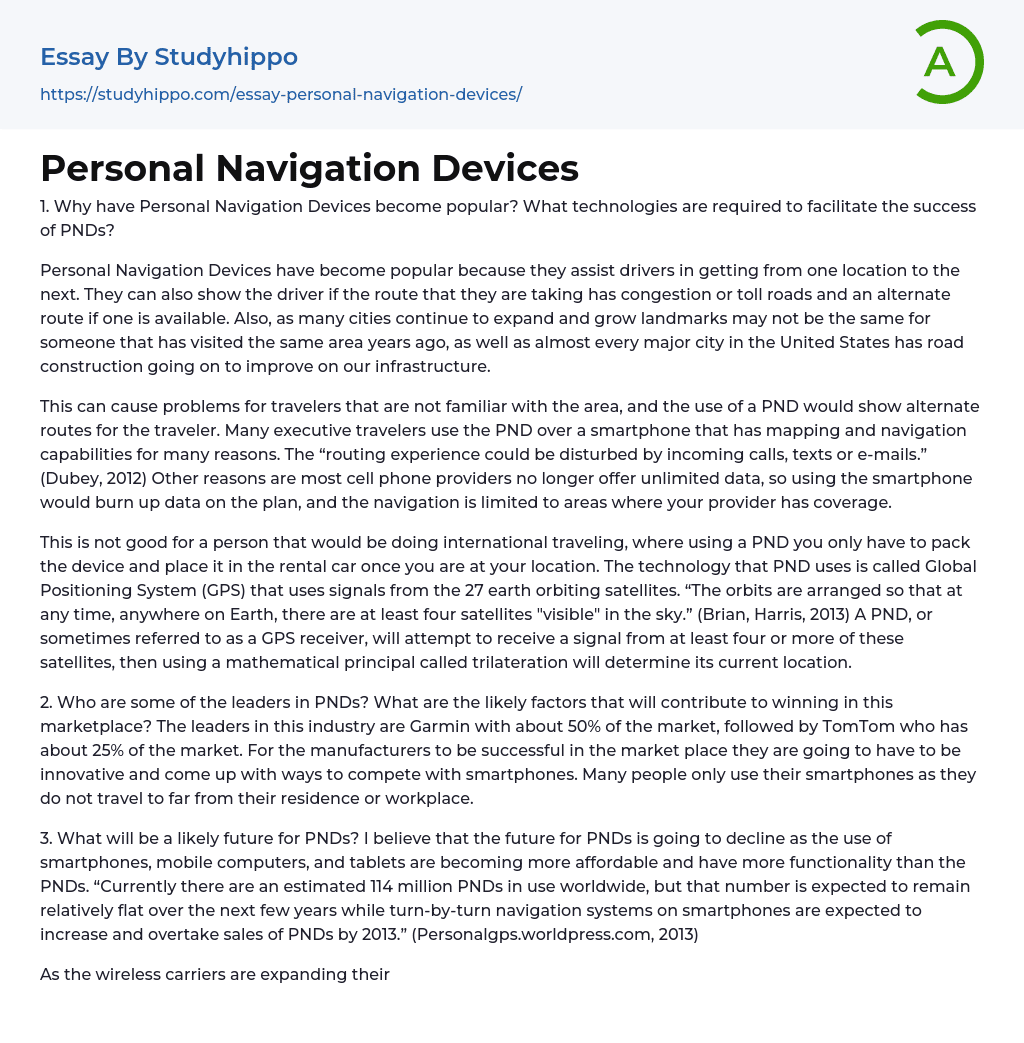What are the contributing factors to the popularity of Personal Navigation Devices and what technological advancements are necessary for their success?
Personal Navigation Devices have become popular for their ability to help drivers navigate and provide real-time updates on road congestion and toll roads. They also offer alternative routes when needed. With cities constantly expanding and changing, it can be challenging for those who have visited the area before to find landmarks. Furthermore, road construction projects are common in major US cities as part of infrastructure improvement efforts.
The utilization of a Personal Navigation Device (PND) can support unacquainted travelers by offering alternative routes to alleviate any challenges they may face in the vicinity. Executive travelers favor PNDs as they enable uninterrupted navigation without disruptions from inc
...oming calls, texts, or emails, which smartphones might induce. Furthermore, limitations on data plans and coverage imposed by cell phone providers restrict the application of smartphones for navigation intents.
The use of a PND, also known as a GPS receiver, is convenient for travelers going abroad because they only need to bring the device and place it in the rental car upon arrival. PNDs operate using Global Positioning System (GPS) technology, which relies on signals from 27 satellites orbiting the Earth. According to Brian Harris (2013), these satellites are strategically positioned so that at least four satellites are always visible from any location on Earth. By receiving signals from four or more satellites and utilizing trilateration, a PND can accurately determine its location.
In the PNDs industry, Garmin and TomTom are the top competitors, with Garmin having a market share of around 50%
and TomTom accounting for approximately 25%. To thrive in this sector, manufacturers need to promote innovation and devise strategies to rival smartphones. The majority of people depend primarily on their smartphones for navigation unless they are near their residence or workplace.
The increasing affordability and enhanced features of smartphones, mobile computers, and tablets are causing a decline in the popularity of Personal Navigation Devices (PNDs). Globally, approximately 114 million PNDs are currently in use. However, it is projected that this number will remain steady in the coming years as sales of turn-by-turn navigation systems on smartphones are predicted to exceed PND sales by 2013.
With the increasing coverage of wireless networks and smartphones' compatibility with global networks, PNDs are becoming outdated. Nevertheless, certain individuals, such as truck drivers and hikers, may still depend on these devices. Furthermore, personnel working in remote areas without wireless providers, like scientists in rainforests, may also need PNDs.
Garmin, a company that encompasses various companies specializing in aviation, consumer, marine, and military GPS technologies, has the goal of maximizing Total Cost of Ownership (TCO) for Personal Navigation Devices. In order to protect their assets and intellectual property, they have patented most of their processes and licensed their software and applications. The only exception is XM Patent. With a significant 50% market share, Garmin excels in multiple GPS-related fields and manufactures devices such as the iQue line of PDA-GPS receivers and GPS-equipped sonar fish finders.
- Data collection essays
- Graphic Design essays
- Data Mining essays
- Cryptography essays
- Internet essays
- Network Security essays
- Android essays
- Computer Security essays
- World Wide Web essays
- Website essays
- Computer Network essays
- Application Software essays
- Computer Programming essays
- Computer Software essays
- Benchmark essays
- Information Systems essays
- Email essays
- Hypertext Transfer Protocol essays
- Marshall Mcluhan essays
- Virtual Learning Environment essays
- Web Search essays
- Etiquette essays
- Mainstream essays
- Vodafone essays
- Web Search Engine essays
- Networking essays
- Telecommunication essays
- Network Topology essays
- Telecommunications essays
- Programming Languages essays
- Object-Oriented Programming essays
- Java essays
- Mobile Phones essays
- 3g essays
- Bluetooth essays
- Cloud Computing essays
- Computer Science essays
- Consumer Electronics essays
- Data Analysis essays
- Electronics essays
- engineering essays
- Enterprise Technology essays
- Hardware essays
- Impact of Technology essays
- Information Age essays
- Information Technology essays
- Modern Technology essays
- Operating Systems essays
- people search essays
- Robot essays




